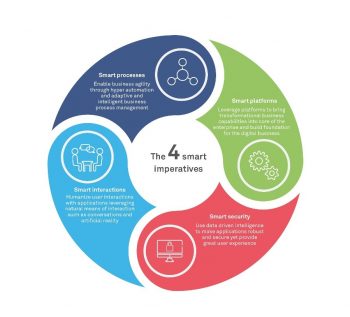In the digital age, success is defined by unlocking the ‘Art of Possible’ to transform the customer experience and align business models to meet evolving customer expectations. Such transformation needs to include highly personalized experiences at every touch-point a customer has with a business. Technologies such as machine learning, artificial intelligence (AI), intelligent process automation (IPA), mixed reality (MR), cloud native computing and the internet of things (IoT) are defining the future of “Smart Applications.” This evolution of applications is inspired by a shift in focus from customer satisfaction to user delight.
Smart applications will help enterprises enable a customer-centric approach across industries. However, incorporating smart applications into the business model isn’t as simple as harnessing the technology. Rather, organizations must take a comprehensive approach to examine how customers interact with these applications, the platforms that bring the applications to life, and how new business processes can enhance experiences in a secure environment. Let’s run through the four key smart application imperatives:

Smart Interactions
What we understand with immutable confidence is how humans interact with other humans. If we could humanize applications by introducing elements of context, emotion, intent and even human biases, interactions with applications will become conversational and natural. The challenge to create smart interactions is to make applications smart enough to mimic human patterns of behavior.
The healthcare industry provides many examples of how smart interactions can provide interesting – and even lifesaving – experiences. Humanizing interactions with technology will help doctors drive better patient outcomes. With privacy controls in place, conversational applications can have instant access to patient health records and medical knowledge databases to provide contextual and relevant answers to patients’ questions. Virtual assistants will help doctors manage patients better by providing access to patient information, appointment details and more. Mixed reality (MR) can be used to train surgeons on newer procedures, visualize a patient’s diagnostic imaging, and to treat a variety of phobias that patients might have.
Smart Processes
Process efficiency, process modeling and process management are still important, but it will be Intelligent Process Automation (IPA) and stakeholder value creation that will be vital to future-ready businesses. Smart processes learn from every run of the process. They adapt to situations and context. They proactively listen to events. And they automate by infusing intelligence and eliminating mundane activity to deliver higher productivity.
Enterprises can reap several key benefits from smart processes, including process re-imagination to penetrate new markets and increased value to the customer. Furthermore, organizations can provide an immersive user experience through the technology of facial recognition, digital signatures, co-browsing, voice-to-text, MR application programming interfaces (APIs) and IoT.
Smart Platforms
The success of the iPhone can be attributed as much to its path-breaking hardware and design as to the iOS app platform that breathes life into it. The platform’s digital services are driving iPhone adoption. One of the key forces behind the success of tech companies such as Amazon, Google, Facebook and Alibaba are the smart platforms they built for their innovative products and services. Organizations such as Uber, Airbnb and Shopify use smart platforms to power their digital products, leading to disruptive strategies and differentiated business models. Smart APIs make their platform capabilities easily consumable and extendable by developers to build valuable experiences.
Ease of extensibility, ability to evolve features continuously, and autonomous behavior to manage complexity defines smart platforms. All the three categories of smart platforms – digital business platforms, horizontal platforms and cloud native platforms – must exhibit these capabilities.
Smart Security
The proliferation of digital surfaces, combined with enterprises embracing new business models, has led to a completely new set of security challenges. Enterprise IT security and risk management functions have not been designed to manage the type of variety, volume and dynamicity being experienced. Enterprises have not necessarily architected their services to secure data in this “X as a Service” world. There has never been a greater need for smart security than in the current 24/7 technology landscape.
Security and risk intelligence controls – the foundation needed to enable digital trust and business resilience – is critical. Beyond addressing operational risks including the threat to brand value, consumer confidence and financial implications of cyber attacks must be considered. As enterprises learn more about smart security they can leverage cognitive, analytics and automation capabilities to respond to threats, defend enterprise assets and enhance resiliency.
Moving Forward
Smart applications are important not only to stay competitive, but also to survive amidst the disruption caused by digital transformation, which is changing industry boundaries and global business models. Embracing the “Art of Possible” with smart applications will play a key role in ensuring success for organizations in today and tomorrow’s technology innovation-driven IT landscape.




True, but the real transformation can take place when these applications adhere to universal accessibility standards (WCAG) which helps in developing an inclusive product catering to all kinds of customers with and without disability